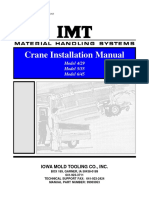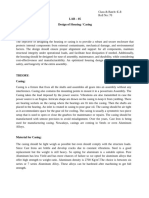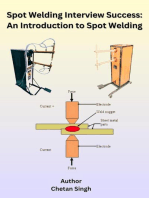AN603 - Thruster Mounting
AN603 - Thruster Mounting
Uploaded by
Ahmad NazriCopyright:
Available Formats
AN603 - Thruster Mounting
AN603 - Thruster Mounting
Uploaded by
Ahmad NazriCopyright
Available Formats
Share this document
Did you find this document useful?
Is this content inappropriate?
Copyright:
Available Formats
AN603 - Thruster Mounting
AN603 - Thruster Mounting
Uploaded by
Ahmad NazriCopyright:
Available Formats
Tecnadyne Application Note AN603 3/11/2006 Page 1 of 2
INSTALLATION & MOUNTING OF TECNADYNE DC BRUSHLESS THRUSTERS 1. Introduction
The purpose of this application note is to describe the most common methods of mounting Tecnadyne thrusters to ROV frames and to the fuselages of faired ROVs and AUVs. While this application note discusses the four most common mounting methods, other approaches that better suit the specific requirements of the customers system may be warranted. Please consult the factory for assistance and recommendations when alternate mounting methods are being considered.
2. Saddle Mount
The saddle mount is the simplest of the four mounting solutions. It is also practical and rugged. A representative saddle mount is shown in Figure 2.1. The saddle shown in Figure 2.1 could be made from aluminum, stainless steel, titanium or plastic and would most likely be welded to the frame of the vehicle, although it could also be bolted to the frame. The tubular frame member shown in Figure 2.1 could also be oriented orthogonally, so that the saddle would bolt or weld to the side wall of the frame member, rather than to the end of the tube as shown. Alternately, the frame member could be a different shape, such as a square tube, channel, I-beam or plastic plates. It is a good idea to place a thin (1-1.5mm) pad of rubber sheet between the thruster and the saddle this rubber pad will prevent the thruster from moving in the saddle and will also protect the thruster. The saddle should have an inner radius equal to the diameter of the thruster housing plus the thickness of the rubber pad. The saddle can be manufactured by machining or by precision roll forming. With the saddle mount, the thruster is held to the saddle using two (or more) stainless steel worm drive hose clamps. The best clamps are the Type 316 stainless steel smooth band clamps manufactured by AWAB in the US these clamps are available worldwide or directly from Tecnadyne. Cover the hose clamps with electrical heat shrink tubing to prevent the clamp from damaging the anodized surface of the thruster. Once the thruster is installed, tighten the hose clamps very tight so as to compress the rubber pad slightly and prevent the thruster from moving during use.
3. Clamp Mount
The clamp mount is shown in Figure 3.1. Specific details of the clamp design and its attachment to the vehicle frame or fuselage are the responsibility of the vehicle system designers. Unlike the saddle mount discussed in Section 2, above, in which a certain amount of imprecision can be tolerated, the clamp mount requires that the clamp be machined to fairly high tolerances. The inside diameter of the clamp should exactly match the outside diameter of the thruster housing (to within 0.1mm). 1 1.5mm of gap should exist between the clamp base and the clamp cap when lightly tightened, to ensure sufficient compression to prevent movement of the thruster. The clamp assembly should be machined from aluminum or plastic material. Plastic material is best since it does not damage the outer surface of the
STAINLESS STEEL HOSE CLAMPS (2) COVERED WITH ELECTRICAL HEATSHRINK TUBING TO PREVENT DAMAGE TO THRUSTER & MOUNT
THIN (1mm) HARD RUBBER PAD TO PREVENT SLIPPING & DAMAGE OF THRUSTER
SADDLE MOUNT WELDED OR BOLTED TO VEHICLE FRAME CUSTOMER FURNISHED Figure 2.1
FASTEN ELECTRICAL CABLE TO VEHICLE FRAME WITH CABLE TIES TO PREVENT DAMAGE
CLAMP MOUNT MACHINED FROM ALUMINUM OR PLASTIC & BOLTED TO VEHICLE FRAME CUSTOMER FURNISHED
5mm SOCKET HEAD CAP SCREWS (4) PLACES
Figure 3.1
MACHINE ID TO MATCH MOTOR HOUSING DIAMETER LEAVE 1.0-1.5mm BETWEEN CLAMP BASE & CAP
Tecnadyne Application Note AN601 1/11/2006Page 2 of 2
thruster and create a corrosion cell, as could happen with an aluminum clamp. Take care to design the clamp for minimum size, so as to not interfere with the water flow into the thruster propeller and nozzle. Secure the clamp cap to the clamp base using 5mm stainless steel socket head cap screws (use 2 screws for Models 250 & 300, 4 screws for Models 520, 560, 1020 & 1060, 6 screws for Models 2010 & 2020). Tecnadyne can design and manufacture clamp mount assemblies to suit all Tecnadyne thrusters and to meet specific customer requirements. Please consult the factory for further details.
4. Blade Mount
Whereas the saddle mount and clamp mount use the standard thruster configuration, the blade mount requires that the thruster housing have integral mounting tabs. Blade mount thrusters are available from Tecnadyne as special order options. Please refer to Figure 4.1 for an illustration of a typical blade mount. Due to the cantilever design of the blade mount option, it is necessary that the blade be constructed from high strength material (generally aluminum). The thruster bolts to the frame using two stainless steel flat head Phillips screws (6 on the Model 8020). As with the design of the clamp mount, specific details of the blade design and its attachment to the vehicle frame are the responsibility of the vehicle system designers. Tecnadyne can furnish the dimensional details necessary to fit the blade to the mounting tabs on the thruster housing. Please consult the factory for additional mounting details of the blade mount option.
5. Nozzle Mount
A mounting technique for faired ROVs and AUVs, the nozzle mount is illustrated in Figure 5.1. Nozzle mount thrusters are available as special order options from Tecnadyne. Since the nozzle mount employs the nozzle as the structural attachment of the thruster to the vehicle, it is necessary to use additional nozzle struts for strength and stiffness. This is illustrated in Figure 5.1. On Model 1020 & 1060 thrusters (and on all larger thrusters) Tecnadyne additionally installs a load bearing stainless steel ring in the outside surface of the nozzle due to the high loads resulting from normal operation and also from wave slap during launch and recovery operations. With the nozzle mount option, the thruster attaches to the vehicle frame or fuselage using four stainless steel flat head screws (6 on the Model 2010 & 2020, 8 on the Model 8020) that are installed from the inside of the nozzle. The nozzle is separated from the frame or fuselage by tubular struts (generally aluminum) the length of these struts is determined by the system designers. The nozzle mount option requires careful integration with the vehicle system -- please consult the factory for additional mounting details prior to system design.
SPECIAL ORDER MOTOR HOUSING WITH BRACKETS FOR BLADE MOUNT
(2) FLAT HEAD STAINLESS STEEL SCREWS
Figure 4.1
CUSTOMER MANUFACTURED BLADE TO FIT BRACKETS ON MOTOR HOUSING
NOZZLE MOUNT REQUIRES ADDITIONAL NOZZLE STRUTS
CUSTOMER SUPPLIED STRUTS MOUNT CUSTOM MACHINED NOZZLE TO VEHICLE FUSELAGE OR FRAME Figure 5.1
You might also like
- Astm D3299Document16 pagesAstm D3299kashif ehsanNo ratings yet
- The Age of Spiritual MachinesDocument10 pagesThe Age of Spiritual Machinesdavidou0201100% (1)
- Aircraft RivetsDocument51 pagesAircraft Rivetsaanand.mce80% (10)
- 1.users Manual Dipstick Mercedes 722.6 722.7 722.8 Professional ToolsDocument2 pages1.users Manual Dipstick Mercedes 722.6 722.7 722.8 Professional ToolsLeonardo SouttoNo ratings yet
- Crane Installation Manual: Model 4/29 Model 5/35 Model 6/45Document20 pagesCrane Installation Manual: Model 4/29 Model 5/35 Model 6/45Bui Hoang DucNo ratings yet
- MSA Roll CagesDocument37 pagesMSA Roll CagesJonathan GridleyNo ratings yet
- VW - 80135 - EN - 2011-10 Threaded Joints For Electrically Conductive ConnectionsDocument6 pagesVW - 80135 - EN - 2011-10 Threaded Joints For Electrically Conductive Connectionshlabidi199No ratings yet
- Calibracion Cilindros Liner MackDocument6 pagesCalibracion Cilindros Liner MackHamilton MirandaNo ratings yet
- WoodWard - Steering Column TechDocument6 pagesWoodWard - Steering Column TechLuiz EduardoNo ratings yet
- Monsoon Horizontal Paddlewheel Aerator Specification: A. GeneralDocument4 pagesMonsoon Horizontal Paddlewheel Aerator Specification: A. GeneralAhmed WagihNo ratings yet
- AD00839V Butterfly Valves Broch - LRDocument44 pagesAD00839V Butterfly Valves Broch - LRMaulia SabrinaNo ratings yet
- DEMCO Butterfly ValvesDocument36 pagesDEMCO Butterfly ValvesLuis Pol SistiNo ratings yet
- Mounting and Alignment Procedure For Main Engine Print 1Document13 pagesMounting and Alignment Procedure For Main Engine Print 1SaniNo ratings yet
- Actuator DX PDFDocument6 pagesActuator DX PDFFelix Enrique MoratayaNo ratings yet
- MP8 - D13 Injector Cup Info 45-sb211007-1Document6 pagesMP8 - D13 Injector Cup Info 45-sb211007-1ONE SOURCE DIESELNo ratings yet
- Demco Gate ValveDocument52 pagesDemco Gate Valver_ergin100% (2)
- 14264A Construction Mechanic Basic Chapters 3 4 PDFDocument73 pages14264A Construction Mechanic Basic Chapters 3 4 PDFDoDuyBacNo ratings yet
- Description Assembly Order No.: Static DataDocument30 pagesDescription Assembly Order No.: Static DataMROstop.comNo ratings yet
- S SE EC CT Tiio ON N 1 1: Section 1Document14 pagesS SE EC CT Tiio ON N 1 1: Section 1Miguel Hernandez Barbosa100% (1)
- High Mast SpecsDocument5 pagesHigh Mast SpecsleodegarioporralNo ratings yet
- Design and Analysis of Connecting Rod For Different Material Using AnsysDocument18 pagesDesign and Analysis of Connecting Rod For Different Material Using AnsysGagan GaganNo ratings yet
- (NF) NB6T136SY, NBT136SY Fitting InstructionsDocument16 pages(NF) NB6T136SY, NBT136SY Fitting Instructionsy65r24khggNo ratings yet
- W02 M58 3001Document30 pagesW02 M58 3001MROstop.comNo ratings yet
- FSAEDocument8 pagesFSAEKaran KhanseNo ratings yet
- Parking Cooler System Nitecool Tcc-100: Installation and Service InstructionsDocument12 pagesParking Cooler System Nitecool Tcc-100: Installation and Service Instructionsebuk123No ratings yet
- Modern Pulley Design Techniques and Failure Analysis MethodsDocument17 pagesModern Pulley Design Techniques and Failure Analysis MethodsSiva SubramaniNo ratings yet
- P1719 Working Document R8 October 2007Document26 pagesP1719 Working Document R8 October 2007metha.d8070No ratings yet
- MSD Lab 5 CasingDocument6 pagesMSD Lab 5 Casingpruthviraj.shinde23No ratings yet
- WP0351Dodge Torque-Arm Family Screw Conveyor Driveshafts - EDocument7 pagesWP0351Dodge Torque-Arm Family Screw Conveyor Driveshafts - Errobles011No ratings yet
- ALIMAK-Scando 650 Tech Desc 9104228-107 USDocument117 pagesALIMAK-Scando 650 Tech Desc 9104228-107 USramtsanNo ratings yet
- SKF CouplingDocument16 pagesSKF CouplingmatchutNo ratings yet
- Construction, Working and Installation of Keyless Shaft Locking DevicesDocument13 pagesConstruction, Working and Installation of Keyless Shaft Locking DevicesJoshua GrahitaNo ratings yet
- AC Induction Motor Specifications White Paper August 2003Document5 pagesAC Induction Motor Specifications White Paper August 2003clide_050793No ratings yet
- Halfen Coupler Mechanical Rebar SplicingDocument33 pagesHalfen Coupler Mechanical Rebar Splicingcarlosfilipegomes3994100% (1)
- Cilinderkopbouten EngelsDocument18 pagesCilinderkopbouten EngelsBabei Ionut-MihaiNo ratings yet
- Brecoflex Polyurethane Timing Belts With Weld On Profiles Us PDFDocument16 pagesBrecoflex Polyurethane Timing Belts With Weld On Profiles Us PDFMikel1020No ratings yet
- Thomson Super Metric Ball Bushing Bearings SpecsheetDocument11 pagesThomson Super Metric Ball Bushing Bearings SpecsheetElectromateNo ratings yet
- TL 5 X 10Document10 pagesTL 5 X 10number_25No ratings yet
- TDS Wabo Elastodec EDocument3 pagesTDS Wabo Elastodec EaomareltayebNo ratings yet
- AA SPEC 371001 - Conveyor Pulleys and ShaftsDocument14 pagesAA SPEC 371001 - Conveyor Pulleys and Shaftsjonodo89No ratings yet
- Thomson BSA Lead and Ball Screws CatalogDocument94 pagesThomson BSA Lead and Ball Screws CatalogElectromateNo ratings yet
- Catalogo Engimax Motores IsuzuDocument38 pagesCatalogo Engimax Motores IsuzuAlexis Sanchez100% (1)
- W01 358 7902Document30 pagesW01 358 7902MROstop.com100% (1)
- Mil DTL 32108Document16 pagesMil DTL 32108syrNo ratings yet
- Power Stream Couplings-Specn SheetsDocument6 pagesPower Stream Couplings-Specn SheetsAmol Patki100% (1)
- Conveyor Pulleys PDFDocument8 pagesConveyor Pulleys PDFDhirendraRaviNo ratings yet
- Conveyor ComponentsDocument26 pagesConveyor Componentswmacadd100% (7)
- Screw Strength DocumentDocument3 pagesScrew Strength Documentmsiddiq1No ratings yet
- Manual de Mantenimiento de Gruas Jib PDFDocument20 pagesManual de Mantenimiento de Gruas Jib PDFalejandroaleman53No ratings yet
- Applications of Pretensioned Anchor Rods in Industrial FacilitiesDocument10 pagesApplications of Pretensioned Anchor Rods in Industrial FacilitiescharlesroberNo ratings yet
- Lycoming Starter AdapterDocument11 pagesLycoming Starter AdapterakNo ratings yet
- Boon Edam Spec Turnlock 100 - 09-20Document7 pagesBoon Edam Spec Turnlock 100 - 09-20druchoxNo ratings yet
- Main BearingDocument28 pagesMain BearingCadet Aviral Jha [9335]100% (1)
- Description Assembly Order No.: Static DataDocument30 pagesDescription Assembly Order No.: Static DataMROstop.comNo ratings yet
- Description Assembly Order No.: Static DataDocument30 pagesDescription Assembly Order No.: Static DataMROstop.comNo ratings yet
- W01 M58 6140Document30 pagesW01 M58 6140MROstop.comNo ratings yet
- A DIY'ers Definitive Guide to Building a Custom Volkswagen TrikeFrom EverandA DIY'ers Definitive Guide to Building a Custom Volkswagen TrikeNo ratings yet
- Bearings And Bearing Metals: A Treatise Dealing with Various Types of Plain Bearings, the Compositions and Properties of Bearing Metals, Methods of Insuring Proper Lubrication, and Important Factors Governing the Design of Plain BearingsFrom EverandBearings And Bearing Metals: A Treatise Dealing with Various Types of Plain Bearings, the Compositions and Properties of Bearing Metals, Methods of Insuring Proper Lubrication, and Important Factors Governing the Design of Plain BearingsRating: 4 out of 5 stars4/5 (1)
- Plymouth and Chrysler-built cars Complete Owner's Handbook of Repair and MaintenanceFrom EverandPlymouth and Chrysler-built cars Complete Owner's Handbook of Repair and MaintenanceNo ratings yet
- The Modern Chassis: A Practical Manual of Automotive Chassis and Suspension DesignFrom EverandThe Modern Chassis: A Practical Manual of Automotive Chassis and Suspension DesignRating: 3.5 out of 5 stars3.5/5 (3)
- Bolted Flanged Joint: Flanges, Studs & Gaskets. Recommended Practices for the Assembly of a Bolted Flange Joint.From EverandBolted Flanged Joint: Flanges, Studs & Gaskets. Recommended Practices for the Assembly of a Bolted Flange Joint.No ratings yet
- Spot Welding Interview Success: An Introduction to Spot WeldingFrom EverandSpot Welding Interview Success: An Introduction to Spot WeldingNo ratings yet
- 193 22109-Fap130506 Ae J PDFV1R4Document19 pages193 22109-Fap130506 Ae J PDFV1R4Luis RoverNo ratings yet
- Inv FMC Cusiana y Cupiagua 1Document10 pagesInv FMC Cusiana y Cupiagua 1Pocholo Mario Pineda ForeroNo ratings yet
- 6MD66xx Manual PIXIT A5 V047100 en PDFDocument110 pages6MD66xx Manual PIXIT A5 V047100 en PDFPiero David Guerrero BernalNo ratings yet
- Mass and Balance OXFORD PPLDocument11 pagesMass and Balance OXFORD PPLStefania TamasNo ratings yet
- UPS HandbookDocument355 pagesUPS HandbookAmmar Naseer100% (2)
- Duct Temp BBX INTDocument2 pagesDuct Temp BBX INTMeher Un Nisa MalikNo ratings yet
- 3D Impact Load Transfer MechanismDocument134 pages3D Impact Load Transfer Mechanismdafo407No ratings yet
- STC-1000 Temperature Controller Operating Manual: or or orDocument1 pageSTC-1000 Temperature Controller Operating Manual: or or orziandNo ratings yet
- CRC+Super+Longterm+Grease+ +MoS2+TDS ENDocument2 pagesCRC+Super+Longterm+Grease+ +MoS2+TDS ENSophia RoseNo ratings yet
- Software Project Engineer in Richland Kennewick Pasco WA Resume Robert VeklotzDocument2 pagesSoftware Project Engineer in Richland Kennewick Pasco WA Resume Robert VeklotzRobertVeklotzNo ratings yet
- Hi-Sincerity: Microelectronics CorpDocument4 pagesHi-Sincerity: Microelectronics CorpEdy MulyadiNo ratings yet
- Electrical Standards SLD Symbols Legend PDFDocument13 pagesElectrical Standards SLD Symbols Legend PDFBuyankhishig MonkhbaatarNo ratings yet
- File Extensions ListDocument234 pagesFile Extensions ListRich RomanNo ratings yet
- Khasra No 681 & 682 Village Katha, PO Baddi District Solan (H.P)Document3 pagesKhasra No 681 & 682 Village Katha, PO Baddi District Solan (H.P)shobhitNo ratings yet
- Janbu, Bjerrum and Kjaernsli's Chart ReinterpretedDocument6 pagesJanbu, Bjerrum and Kjaernsli's Chart ReinterpretedviperturkNo ratings yet
- 42 AS-F-HSE 042 - Inspection Checklist For Construction EquipmentDocument3 pages42 AS-F-HSE 042 - Inspection Checklist For Construction EquipmentJHUPEL ABARIALNo ratings yet
- HP SondeDocument12 pagesHP SondeNamik HadziibrahimovicNo ratings yet
- Networx: Rsnetworx For Devicenet Getting Results GuideDocument62 pagesNetworx: Rsnetworx For Devicenet Getting Results GuideCarlos MusellaNo ratings yet
- mp-vc16&vc8 PDFDocument72 pagesmp-vc16&vc8 PDFTran DuyNo ratings yet
- Toyota 1ZZ FE 3ZZ FE Engine Repair Manual RM1099E PDFDocument141 pagesToyota 1ZZ FE 3ZZ FE Engine Repair Manual RM1099E PDFJhorwind Requena83% (18)
- Reporte Icc Esr - 3517Document5 pagesReporte Icc Esr - 3517Fernando Castillo HerreraNo ratings yet
- Abyssws WinDocument106 pagesAbyssws WinAdi Toto HaryonoNo ratings yet
- Quant ShareDocument154 pagesQuant SharemgsterrorNo ratings yet
- B08 3 A6t PDFDocument2 pagesB08 3 A6t PDFRakESaN SoundwangS100% (1)
- Analysis of Boost Converter Using PI Control AlgorithmsDocument3 pagesAnalysis of Boost Converter Using PI Control AlgorithmsTrương Văn TrọngNo ratings yet
- Quick-Start QGIS TutorialDocument7 pagesQuick-Start QGIS TutorialmsidqiNo ratings yet
- Neutron DK7740 Wire Cut Machine FullDocument28 pagesNeutron DK7740 Wire Cut Machine FullAmeer shattiNo ratings yet

























































































